Month 6:17, Week 3:2 (Shanee/Matzah), Year:Day 5941:164 AM
2Exodus 4/40
Gregorian Calendar: Thursday 7 September 2017
The Hebraic Roots Bible
A Preliminary Assessment
IV. The Style in Genesis & John
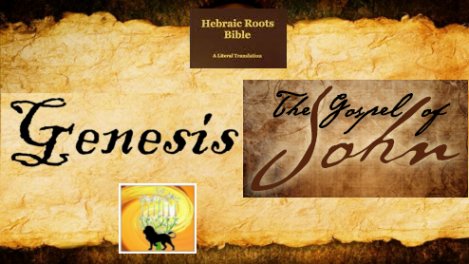
Continued from Part 3
Introduction
In the concluding part of this study of the Hebraic-Roots Bible (HRB) we are going to look at the English and style with particular reference to two books - Genesis and John - which I have picked out because I know them in depth academically as well as theologically.
What is a 'Literal' Translation?
But before we do that, I need to clear up one misperception, namely, that the HRB is (as stated on its title page) "A Literal Translation". I have to categorically state that this it absolutely is not because a literal translation would be virtually meaningless. And though, it is true, scholars often refer to Bible versions like the New American Standard Bible (NASB), English Standard Version (ESV) and King James Version (KJV) as 'literal' or 'word-for-word' versions, they are actually far from that. Yet they are far closer to that 'ideal' than dynamic equivalent or paraphrase versions like the Complete Jewish Bible (CJB), New International Version (NIV) or New Living Translation (NLT).
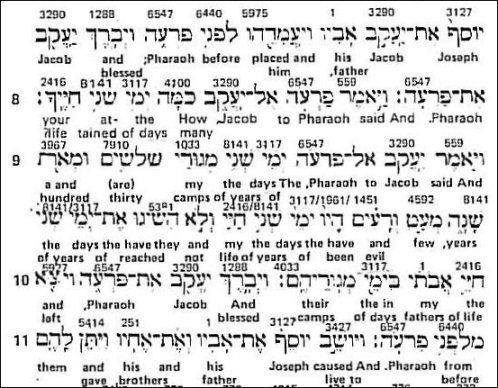 A Sample from an Interlinear Bible (Genesis 47:7b-11a)
A Sample from an Interlinear Bible (Genesis 47:7b-11a)
Interlinears as Word-For-Word
The nearest I have come to a Bible version that approaches this category is the Concordant Literal New Testament (CLNT) and the parallel Concordant Version of the Old Testament (CVOT) but even these are strictly-speaking not word-for-word translations either, as you will see. The nearest to such a species would be an Interlinear Bible which, if you read out to a congregation, would cause much confusion and headache after a while. To illustrate my point, let's take a look at a passage from Esposito's Bible and compare that to a word-for-word translation and to the CVOT:
"In the beginning Elohim created the heavens and the earth; and the earth being without form and empty, and darkness on the face of the deep, and the Spirit of Elohim moving gently on the face of the waters, then Elohim said, Let light be! And there was light" (Gen.1:1-3, HRB).
"In the beginning created Elohim the heavens and the earth and the earth was without form and empty and darkness on the face of the deep the and of spirit elohim moving gently on the face of the waters then said elohim let be light and was light" (Gen.1:1-3, The Interlinear Bible by Jay P.Green, Sr.)
"Created by the Elohim were the heavens and the earth. Yet the earth became a chaos and vacant, and darkness was on the surface of the submerged chaos. yet the spirit of the Elohim is vibrating over the surface of the water. And saying is the Elohim, 'Become light!'" (Gen.1:1-3, CVOT)
Notice that the original Hebrew has no puncuation marks or capital letters. This is a relatively easy passage to translate as there are no complex words and the only issue is one of simple word order or syntax.
A 'Difficult' Passage: Genital-Groping and Hand-Chopping
Here is a more difficult passage to translate as well as being controversial:
 "When men fight together, a man and his brother, and the wife of the one shall come near to deliver her husband from his assailant's hand, and shall put out her hand and lay hold on his genitals, then you shall cut off her palm; your eye shall not pity" (Dt.25:11-12, HRB)
"When men fight together, a man and his brother, and the wife of the one shall come near to deliver her husband from his assailant's hand, and shall put out her hand and lay hold on his genitals, then you shall cut off her palm; your eye shall not pity" (Dt.25:11-12, HRB)
This is a strange translation even without the doctrinal controversy of hand-chopping (the only one in the Torah, incidentally). In reading Esposito's translation I do have to ask the perfectly reasonable question: How do you cut off someone's palm (the inside of the hand) without the dorsum/dorsal/outside part of the hand too? The word hdy means a 'whole hand' - how do you cut the 'palm' off and not the fingers too? Accordingly every translation that I know uses "hand". Esposito does not explain in a footnote his strange choice of word even though, as you will see, I have managed to trace his source.
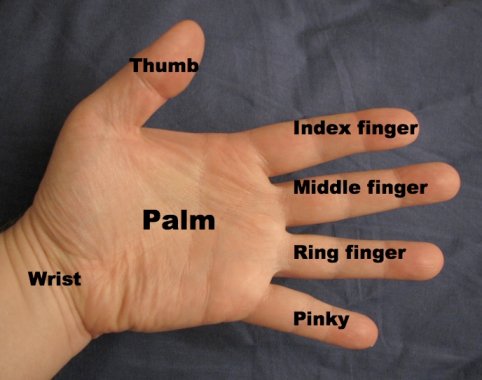 The palm is the central part of the ventral (underside) of the hand
The palm is the central part of the ventral (underside) of the hand
A Jewish Exegesis
The Torah Commentary of the Jewish Publication Society (JPS) (the version used by Stern and Trimm as the basis of the Tanakh/Old Testament portions of their CJB and HRV translations) offers an interesting explanation in view of the apparent harshness of the punishment for destroying a man's ability to produce more children:
"The meaning is: If a person is attacking another in a potentially lethal way (such as seizing his genitals, which is considered a lethal spot), you may even wound the attacker if that is necessary to save the victim (‘you may even cut off her hand’); if that doesn’t suffice, you may kill the attacker (‘show no pity’)."
A Comparitive Ancient Assyrian Law
This is certainly an interesting way of looking at the passage and it is a fact that a similar law was in force in the ancient Middle East, specifically in Assyria:
"If a woman has crushed a man’s testicle in an affray, one of her fingers shall be cut off. And if, even though a physician has bound it up, the other testicle has become affected along with it and becomes inflamed, or if she has crushed the other testicle in the affray, they shall tear out both of her {last word missing from text}..."
So such a law would not have sounded strange to ancient Israelite ears when they first heard it read out to them by Moses. Now I can understand how Esposito came to choose 'palm' but I don't understand 'why' he chose (for the reason already given).
'Into the Hand Of'
There are two different Hebrew words (yad and kap), the second of which is polyvalent. It can mean 'palm', 'sole of the foot', 'bowl', 'hip socket', 'handful', and 'control'. Here's an example of the latter's usage in the Tanakh (Old Testament):
"But now Yahweh has cast us off, and given us into the hand of Midian" (Judges 6:13).
An Alternative Meaning
Since different words are used, it is reasonable to assume different meanings are intended. In addition, the word translated as "cut off" (qss) is also used to mean take away or remove. Given that the passage comes immediately after one about a woman's right to a levirate marriage (in which a widow is instructed to pull off her brother-in-law’s sandal and spit in his face if he refuses the marriage), perhaps the punishment has to do with marriage rather than mutilation. Perhaps she is 'cut off' from her husband, or the community. I certainly consider this a plausible explanation. What I don't understand is why Esposito chose 'palm'. [1]
Problems Translators Face
Here's the problem that translators face. The meaning of words can be complex and changing. For instance, we still don’t really know what "selah" means despite it being used 74 times in the Tanakh (Old Testament) and truly scholarly and honest translators will admit this in their footnotes. It is better to admit you don't know what a word or phrase means than to make a wild speculation that can damage the integrity of the Davar (Word).
Translation Styles, Biases and Temptations
Every Bible translation has its own English 'style' and the HRB is no exception. No two translations are alike in that respect and all have to find a 'place' somewhere between the Interlinear (which contains the original-language text along with a word-for-word rendering into the target language) and the Paraphrase (which is the original message freely restated in a way that the translator thinks the target audience will positively respond to). The first is rarely fully intelligible and the latter tends to take liberties - there is just too much temptation for the translator to inject his own biases and prejudices into the text, not that the same temptation doesn't exist even in so-called 'literal' translations, mind you.
The Basis of a Good Translation
A good traslation must seek to be both accurate and intelligible and so you are forced to strike a balance between these two extremes. These versions of the Bible strive to convey the meaning and flavour of the original-language expressions while also making the text easy to read to a modern readership. Two modern Bible versions that are successful in this balancing act are the New Revised Standard Version (NRSV) and English Standard Version (ESV).
The Problem of Semi-Literacy
But there is a problem, not with the excellence of such versions, but with the increasing numbers of English-speakers who are semi-literate. What do you do for those who have been processed by the current educational system which is bent on dumbing-down its citizens and giving them a minimalist vocabulary in order to be functioning factory workers only? How do you reach people born and raised in various ganglands where an entirely independent street English has evolved that is unintelligible to everyone else? As far as the latter is concerned, sometimes an extreme paraphrase using pithy language and modern terminology might, and taking huge liberties with the original text, might be the only way someone caught in that milieu can get a first acquaintance with the Davar Elohim (Word of God). Later, as his English improves, he can be introduced to a better translation. I have myself on occasion used 'Bikers' and 'Sportsmens' paraphrase Bibles to make an initial penetration into that environment. Of course, if there is full illiteracy, then the spoken word of the evangelist or missionary will have to do.
The Decay of the English Language
English as a language is regrettably in steady decay everywhere and there are few left who can speak it as it existed when I was a child. The vocabulary of the average person has shrunk by about three quarters even in my lifetime. Accordingly, we do need 'simplified versions' like, for example, the New International Readers' Version (NIRV) which breaks the text into short sentences that the less able are better able to disgest and comprehend. Even I find that helpful sometimes when grappling with Paul's mammoth sentences. Part of the mission of the Body of Messiah must, in addition to teaching the Besorah (Gospel), also be to improve literacy. You only have to see that the apostle Peter, who began as a temperamental illiterate Galilean fisherman, became a sophisticated writer by the time he wrote his two letters, leading sceptics to insist that there were two different authors. This means the Body of Messiah needs both types of Bible - both the 'literal' as well as the dynamic equivalent - to meet the needs of different degrees of literacy.
Readability
Whatever your view of dynamic equivalent versions of the Bible like, for example, the New International Version (NIV) or the New English Bible (NEB) may be, no one can argue that they are not very well written and eminently readable. All good translations make an effort at making the text pleasurable to read so as not to disrupt the reader's flow and grasp of the bigger concepts being relayed. In that regard, the King James Version (KJV) was a literary masterpiece for its time but its English today is far too antiquated for most. I know a lot of diehard 'King James Onlyers' who maintain that the old English is easy to understand and yet who have a very poor picture of bigger concepts because they are struggling with what is essentially two languages - their's and King Jimmy's. The best kind of thinking is done, and the best comprehension results, when you only have to process one language at a time.
A Liberal Stylist Damages an Otherwise Good Translation
Good translators must be skilled not only in the English language itself but be acquainted with its best literature so as to exploit the language to its fullest. The NIV committee even employed its own stylist to give the translation cadence and flow, and in that respect Dr. Virginia Mollenkott did an excellent job. But there was a problem. She was a lesbian, monist [2] and admitted that she was not adverse to lying in order to serve her political agenda. In many ways the NIV was both blessed and spoiled by her work. Little wonder, then, that after the NIV's stylist had done her work, all censuring of homosexual activity, which is clearly present in the original text, was nowhere to be found in that otherwise good Bible translation.
Gender-Neutral Versions
Many modern versions, sadly, incorporate to some degree the thought and behavioural biases of the cultures in which they were spawned, thereby spoiling them. Even good ones like the New Revised Standard Version (NRSV), because of their tampering by people with a politically correct agenda, are what we call 'gender-neutral' or 'egalitarian translations' which go out of their way to eliminate male-only references, though I have to say that, for the most part, the NRSV is honest enough to include footnotes where these changes have been made. The result is that the original sense and meaning of the Biblical texts are distorted and divine tavnith is (pattern) destroyed.
How Political Correctness Can Spoil a Prophetic Scripture
Here's an example of how a well-meaning attempt to make the Scriptures appear more 'inclusive' results in mutilation and the destruction of a prophecy [3]. Psalm 34:19 in the more traditional New International Version (NIV) reads:
"A righteous man may have many troubles, but the Lord delivers him from them all; He protects all his bones, not one of them will be broken" (Ps.34:19, NIV)
John Explains Isaiah
As we know, John 19:36 clearly says that the verse is a prophecy for the crucifixion of Messiah. But in the Today’s New International Version (TNIV), the verse now reads:
"The righteous may have many troubles, but the Lord delivers them from them all; He protects all their bones, not one of them will be broken" (Ps.34:19, TNIV).
No Right to Change Scripture
Such a change obscures the prediction of the Messiah and drastically distorts the original text. The connection between the two passages is not now so obvious or clear as the original made out. This is why we must never change the original meaning simply to please the ever changing whims of fallen men and women.
The NRSV Mutilation
The conservative ESV is faithful to the original but not the liberal (and scholars' favourite) NRSV:
"Many are the afflictions of the righteous, but the LORD rescues them from them all. He keeps all their bones; not one of them will be broken" (Ps.34:19, NRSV).
Muddled by Feminism
The feminists of the NRSV translation committee simply point the reader to John 19:36 without informing the reader of their gender-neutral mutilation. Very bad form indeed. As the translations of the messianic versions tend to be conservative (conserving the original), they tend to translate correctly.
The NRB is Faithful
Here Esposito is faithful:
 "Many are the evils of the righteous, but YAHWEH delivers him out of them all, keeping all His bones; not one of them is broken (Joh 19:36, Ex 12:46)" (Ps.34:19, HRB).
"Many are the evils of the righteous, but YAHWEH delivers him out of them all, keeping all His bones; not one of them is broken (Joh 19:36, Ex 12:46)" (Ps.34:19, HRB).
But What of the Ruach?
Sadly, he does not show the same consistency when it comes to the gender of the Ruach haQodesh (Holy Spirit), though to be fair, neither does nearly every other translator because there is too much doctrinal tradition at stake so Esposito can hardly be singled out. He's just following the 'messianic stream'. However - and this is the crux because of his grand claim - he is not restoring the 'original Bible' in doing so [4].
PART IV
A Review the English Style and
Text of Genesis and John
A KJVesque Version
If you are a fan of King James Version (KJV) and the New King James Version (NKJV) because you like their grammar, syntax, style and language in general, then you'll probably feel comfortable with Esposito's Hebraic-Roots Bible (HRB). Though it doesn't flow nearly as well as the KJV and NKJV and sometimes uses word combinations that are bizzare to say the least, it certainly has the same kind of 'feel' as the KJV and NKJV and for that reason I describe it as 'KJVesque'. In reality is it probably more like the KJV but with out the 'thee's' and 'thy's' and 'thou's' and, of course, using 'YAHWEH' instead of 'LORD', 'Elohim' instead of 'God' and 'Yahshua' instead of 'Lord' and 'Jesus', like all standard messianic versions.
More Like the KJV or NKJV?
Having said the HRB is 'KJVesque', it is nevertheless Esposito's own (or a borrowed) style trying to mimick a form of English that has been dead in the wider English-speaking world for over four centuries, and frankly I don't see the point unless he's simply doing it that way because that's what he personally likes...which is fine if that's the reason. I think he would have done better simply revising and messianising the NKJV, were that possible, but as that is copyrighted, Esposito was basically stuck with revising the KJV (which, incidentally, is also copyrighted though most people don't know that) and that seems to be what he has done ... just like Koniuchowsky in his RSTNE (although Koniouchowsky differs in substituting in a great multitude of Hebrew words).
Nearest Translation Relatives of the HRB
So I sat down and read through Genesis and John in the HRB and compared it with those it most closely resembled: the KJV, NKJV and RSTNE, along with the Septuagint (LXX) because Esposito stresses the importance of this Greek translation to him. I also refer to other versions as I feel led to do so. Aside from the modification of some words (sometimes detrimentally, as we have seen with the 'palm'/'hand' case), the HRB is basically a reworked KJV text as opposed to a retranslation in the KJV style like the NKJV. And whilst Esposito certainly uses LXX renderings where these differ from the Masoretic Text, I don't get the impression that the LXX as a whole is his ground text. But I could be wrong.
PART A - GENESIS
1. A TALE ABOUT SPROUTS, GRASS AND VEGETATION
Let's start with a simple example from the creation narrative in Genesis:
  "And Elohim said, Let the earth sprout tender sprouts, the herb seeding seed, the fruit tree producing fruit according to its kind, whichever seed is in it on the earth. And it was so" (Gen.1:11, HRB).
"And Elohim said, Let the earth sprout tender sprouts, the herb seeding seed, the fruit tree producing fruit according to its kind, whichever seed is in it on the earth. And it was so" (Gen.1:11, HRB).

It would appear that Esposito has taken his Interlinear Bible and simply transliterated afl ... afrt, "let sprout (dasha) ... [tender] sprouts (deshe)".
"Then God said: 'Let the earth cause grass to sprout, seed-bearing plants and fruit trees according to their kinds, yielding fruit along with seed on the earth'. And it was so" (Gen.1:11, NWT2e).
"And God said, Let the earth bring forth the herb of grass (lit. 'sowing') bearing seed according to its likeness, and the fruit-tree bearing fruit whose seed is in it, according to its kind on the earth, and it was so" (Gen.1:11, LXX).
"And God said, Let the earth bring forth grass, the herb yielding seed, and the fruit tree yielding fruit after his kind, whose seed is in itself, upon the earth: and it was so" (Gen.1:11, KJV).
"Then God said, 'Let the earth bring forth grass, the herb that yields seed, and the fruit tree that yields fruit according to its kind, whose seed is in itself, on the earth'; and it was so" (Gen.1:11, NKJV).
Usually 'Grass' or 'Vegetation'
Almost every translation either renders this "grass" (the majority) or "bring forth/produce vegetation": the New Revised Version (NRSV), Orthodox Jewish Bible (OJB), New International Version (NIV) and New American Bible (NAB) use "vegetation" and the English Standard Version (ESV) "sprout vegetation".
To Sprout Sprouts
Esposito alone seems to like to "sprout...sprouts" which, though not technically wrong, is somewhat of a tautology and not as precise. The reason no translator uses Esposito's rendition is that the noun 'sprout' either means 'a shoot of a plant' or is an abbreviation for 'Brussels sprout'. Using 'vegetation' (the best rendition in my view) or 'grass' removes all ambiguity. Which verb - 'bring forth', produce' or 'sprout' makes little difference but 'sprout sprouts'...well, it just isn't good English if it's a quality translation you're looking for. It's a question of style.
2. THE CREEPING CREEPERS
  Esposito follows the same practice with "all the creepers creeping on the earth" (Gen.1:26, HRB), borrowing this directly from Jay P. Green's Interlinear Bible as opposed to the Septuagint which has "all the reptiles that creep on the earth" (LXX), but similar to "every creeping thing that creepth upon the earth" (KJV). You'll find most versions and Interlinears (Kohlenberger's uses 'crawler'), which are based on the Masoretic Text, using 'creatures' or 'creepers' that 'crawl', 'creep' or 'move along' the 'ground' or 'earth'. Thus "all the creeping creatures that creep on the ground" is Koster's choice in the ISRV and HS.
Esposito follows the same practice with "all the creepers creeping on the earth" (Gen.1:26, HRB), borrowing this directly from Jay P. Green's Interlinear Bible as opposed to the Septuagint which has "all the reptiles that creep on the earth" (LXX), but similar to "every creeping thing that creepth upon the earth" (KJV). You'll find most versions and Interlinears (Kohlenberger's uses 'crawler'), which are based on the Masoretic Text, using 'creatures' or 'creepers' that 'crawl', 'creep' or 'move along' the 'ground' or 'earth'. Thus "all the creeping creatures that creep on the ground" is Koster's choice in the ISRV and HS.
Where Did the Greek Reptiles Come From?
Here is my question. If Esposito is following the Greek Septuagint (LXX) [5], as has been claiming, rather than the Hebrew Masoretic Text, why has he used "creepers" instead of the LXX's erpeta, "reptiles"? He certainly follows the LXX in a number of places where it disagrees with the Masoretes. The Greek translators, who used the pre-corrupt Tanakh (Old Testament), were closer to the 'Original Bible' Esposito is supposed to be restoring than the Masoretes. Again, there is nothing wrong with the HRB "creepers creeping" translation - but is it the best rendition?

Greater Care Needed in Citing Sources
Although the Hebrew Dead Sea Scrolls (DSS) are younger than the Greek Septuagint (LXX), they are not far removed in time from one another. 4Q2, 4Q4 & 4Q10 DSS Genesis manuscripts all use the traditional "every creeping thing that creeps on the earth" so I think it is fair to say the Masoretes have not got hold of this particular verse. Personally this is the one I would go for so I will not fault Esposito in sticking to the traditional rendition. Why the 70 Greek scholars plumped for "reptiles" is a bit of a mystery. One thing Esposito's apologists do have to be careful over is making such statements that the Tanakh (Old Testament) part of the HRB is based on the LXX when clearly it often isn't.
What Led to Translation Choices - Scholarship or 'the Spirit'?
If the LXX isn't the only source that has been consulted (which is perfectly fine as all scholars do this) then what is needed is an exhaustive commentary telling us where the world's allegedly one-and-only 'Restored Bible' is getting its translation material from. To make such a fantastic claim requires more rigorous scholarship reporting. I just hope Esposito won't try the "inspired by the Spirit" cop-out that some 'translators' fall back on when they choose a rendition thich they prefer. Anyone can say that but no-one can, of course, test it without themselves resorting to the "Spirit told me your Spirit-directed choice was mistaken". More often than not such esoteric claims are made to cover up poor scholarship. Since Esposito does not claim to be a scholar, may we know on what bases he makes his choices, and why? If his answer is "the Spirit" then frankly we don't need to take his claims seriously since nothing can then be critically tested or proved (e.g. 1 Thes.5:21).
The HRB Guided by the 'Spirit'
Unfortunately, this is exactly what he says in his introduction to the HRB:
"I will also publicly state that I am firmly convinced that it was the Holy Spirit’s inspiration and not the intellectual knowledge of myself that has put this Hebraic Roots Bible together. I have fervently prayed and asked our Heavenly Father for guidance throughout the five years that I have been working on this project. I can also tell you that many times while doing this work I felt the spirit of YAHWEH directing and guiding me to the finished work of this translation. This work is to the glory of YAHWEH for the end time remnant to have the closest manuscript possible to the original scriptures that were inspired for the Congregations of YAHWEH."
Study and Intellect Clearly Involved
And yet, of course, intellectual knowledge and processing is always involved and it is easy to prove what Esposito's sources are for the most part. What Esposito did not do was get a dictation from the 'Spirit' as Joseph Smith claimed for for his 'Inspired Version' of the Bible. Though he doesn't tell us, he undoubtedly means that he was 'guided' to this 'source' or that 'translation' or that 'scholar' and indeed goes on to say that "I have studied and perceived that some translations are third and forth generations away from the original language", so studying is clearly involved.
A Special Anointing?
I am sure every believing translator seeks for the guidance of the Ruach (Spirit) and yet mistakes are inevitably made because the vessels are fallible. Unless Esposito is claiming a special, unique 'anointing' of the Ruach (Spirit) unlike anything given to other translators...I sincerely hope he isn't because there are some blunders in his HRB...then he must expect his work to be examined and judged like any other translator's work. If he is claiming his lack of scholarship is to be compensated for by the 'Spirit' guiding him - and Yahweh can, of course, do this - then I'm afraid he is in trouble because on balance I think his translation is worse than a whole slurry Bible versions, putting True Names and the like aside. And some of it is appallingly bad, as we shall see.
3. THE MYSTERY OF THE SOUL
Passages like Genesis 2:7 are the favourite play-thing of Jehovah's Witnesses, Seventh-Day Adventists, Armstrongites (Worldwide Church of God, which Esposito was once a member of) and others but who, without realising it, are handicapped by the English language itself:
  "And YAHWEH Elohim formed the man from the dust of the ground, and blew into his nostrils the breath of life; and the man became a living soul" (Gen.2:7, HRB).
"And YAHWEH Elohim formed the man from the dust of the ground, and blew into his nostrils the breath of life; and the man became a living soul" (Gen.2:7, HRB).
The problem with using words like "soul" is not only that its meaning has changed over the centuries but that it is loaded with Catholic theology. I don't want to get into a huge discussion about this (as I have already written extensively on this topic over the years) other than to say that the JW's, SDA's, WCG'ers, Esposito and others oversimplify the issue. So complex is the etymology of the word 'soul' that The Compact Edition of the Oxford English Dictionary, which is over 4,100 pages long in microscopic print (it would be about 10,000 pages long if printed in regular font - the version I have has to be read with a magnifying glass) devotes over 13 whole pages to analysing the word 'soul' [7]. To cut a very long story short the word 'soul' (in its numerous spellings from sawol to soule), in the English language is meant no more than the principle of life before it started acquiring a specific theological anatomy. And that is very much the overall sense that word nefesh has in Hebrew.

My First Theological Study
Over the last 30-40 years I have had numerous discussions with Witnesses, Adventists, Armstrongites, Christadelphians and Messianics over the meaning of this pesky word. Indeed, it was over this very question that I made my very first in-depth theological study in Oxford, The Bible Teaching on 'Soul' which arose out of these discussions and my own research with my own out-of-body experience when I was a boy in the back of my mind.
Nephesh Doesn't Mean Just One Thing
Here's the problem: the word nefesh/nephesh doesn't just mean one thing but was used by the ancients to describe a variety of different states, including a dead body (e.g. Lev.19:28; Num.6:6; Hag.2:13)! No doubt there was a reason Yahweh inserted chai ('living') in front of nefesh. Whole false theologies have arisen around trying to make nefesh fit one meaning, including Esposito's, as I briefly discussed in the article on HRB footnotes (see #B9).
The Implications of the Soul-Sleepers
Those of the false Soul-Sleeping school (SSS) have this primitive notion that a human being is little more than a lump of clay or physical body into which the 'Spirit of God' was breathed leaving it in the same condition (physical molecules + Divine Breath) so that when a man dies, this 'Spirit' or 'Breath' leaves him, returns to Elohim (God), the body decomposes, and the dead man has no more existence in any state. This is what they understand the biblical metaphor describing the dead as 'sleeping' means even though it is rather hard to conceive of a non-existent person 'being asleep', let alone in Yahweh's head. To the soul-sleeper, he is no more than a memory in Elohim's (God's) 'mind', to be re-created later at the resurrection, at which point the Final Judgment takes place and the resurrected wicked are annihilated. (Why bother to wake the wicked up to just tell them they are about to be exterminated?) There are other theological ramifications to this notion.
The Other Catholic/Protestant Extreme
At the other end of the spectrum is the Catholic notion that the 'soul' (by which they mean 'spirit' or the invisible part of man) is immortal (cannot die or be annihilated) and is therefore destined to eternal life in heaven or eternal damnation in hell, a notion pretty much inherited wholesale by Protestantism.
The Simple Biblical Formula
Though it is oversimplistic, the basic (but not exclusive) nefesh formula in the Tanakh (Old Testament) is:
Physical Body + Invisible Spirit/Life of Man = Soul (nefesh)

How Many Divine Breaths Do We Have?
Soul-sleepers deliberately try to keep the nefesh or 'spirit' part impersonal by translating it as "breath", as Esposito so does, forgetting that there are three words in Hebrew that may be translated as 'breath', namely, neshamah, ruach and nefesh which mostly are not interchangeable. Remember, Yah'shua 'blew' the Qadosh (Holy, Set-apart) "Ruach" or "Spirit" into His talmidim (disciples) who already had the 'Breath of Life' that Yahweh originally breathed into Adam, meaning that the talmidim now had at least two kinds or doses of 'spirit' in them, as do we who are born again if you take this literally:
"Again [the resurrected] Yah'shua (Jesus) said, 'Peace be with you! As the Father has sent me, I am sending you.' And with that He breathed on them and said, 'Receive the Ruach haQodesh (Holy Spirit)" (John 20:21-22, NIV).
Impossible Questions Arising Out of Literalism
Now if you approach this with a Western scientific literalist mindset you can get into one unholy theological mess and ask such unanswerable questions as, 'Do believeres have both the Spirit of the Father and the Spirit of the Son?' 'What is the difference between them?' 'When a born-again person dies, do both spirits leave him?' 'Why doesn't Yah'shua (Jesus) breathe on us when we are born again today?' By doing this, you end up reading far more into a language which had a miniscule vocabularly compared to our English one.
Merely Energy Into Clay?
I am frankly surprised that Esposito used the old Teutonic word "soul" at all, given its dozens of possible meanings and nuances and uncertain etymology. Wise messianic translators just use the word 'nefesh' (or 'nephesh') and leave it at that. Whatever the Ruach Elohim (God) did at the creation of Adam, He/She/It (which of these belongs to another discussion) did more than simply inject energy into clay. Given man's spiritual pre-existence, it has to be more than the impersonal electricity-like force which the Witnesses et al view the Person of the Ruach haQodesh (Holy Spirit) as being. It's a LOT more complex than their Elementary School Science mentality would have us believe. But 'soul' is an Armstrongite favourite and given Esposito's background it is perhaps not surprising that he continues to use it.
Understanding Biblical Metaphors
Classical Hebrew is a very poetic language laced with literary devices called metaphors. A metaphor is a comparison made between two or more things using figurative or descriptive language, like 'clay' and 'breath' compared to 'physical body' and 'spiritual body', respectively. Metaphors both serve to make difficult-to-understand ideas or concepts more tangible as also to infuse written text with vivid descriptions that make the text more vibrant and enjoyable to read. The Clay/Breath picture is a poetic simplifcation of what was undoubtedly a very (for us) complicated and amazing process that could be understood by all cultures across time.
Clay Equates With Subjection to Design and Influence
Consider also how the 'clay' metaphor is used elsewhere in Scripture:
"But now, O Yahweh, You are our Father, we are the clay, and You our potter; And all of us are the work of Your hand" (Is.64:8).
What does it mean that we are "clay"? It means, quite simply (and no more than this) that we are subject to Yahweh's design and influence. Once you start thinking like a modern analytical Westerner, you start missing the point altogether.
The Chemistry of It All
Think about it (and here I am speaking as both a Biochemist and a Theologian). What is clay made of chemically? The minerals in clay are hydrous aluminium phyllosilicates, sometimes with variable amounts of iron, magnesium, alkali metals, alkaline earths, and other cations. This is not sufficient to build a human being which requires large amounts of other elements and compounds not found in clay. So obviously Yahweh is not simply 'blowing' into hydrous aluminium phyllosilicates - we're not even silicon-based! You can argue, if you want to, that Yahweh supernaturally created all the missing elements out of the polysilicates but that is to miss the point entirely - this is not a description of a supernatural scientific process. It's simply saying that Yahweh took physical material, supernaturally and shaped it with His own very personal chayim or life energy and intelligence, and inserted 'us' into that wondrous, complicated vessel we call a body!
 From clay polysilicates (above) to complex biochemical machinery (below)
From clay polysilicates (above) to complex biochemical machinery (below)

I am a Nefesh
I am a nefesh, an incredible divine synthesis of matter and spirit that I don't suppose I will ever fully comprehend. When my physical body dies my spirit - me, my essential invisible, living personal self - will continue to live on, not because it is independently 'immortal' but because I am connected to the source of eternal life by design and movement. He could 'pull the plug' on my existence whenever He wanted to, but he won't, and I will still be able to commune with Him when I am physically dead and awaiting the physical resurrection. I am not mere 'impersonal breath' - I am a conscious entity, whether embodied or disembodied. And this is something that Don Esposito, Herbert Armstrong, Charles Taze Russel, Ellen White and others never got, and still don't get.
4. CAIN'S ANGRY GLOW?
 "And YAHWEH said to Cain, Why have you angrily glowed, and why has your face fallen? If you do well, is there not exaltation? And if you do not do well, sin is crouching at the door; and its desire is toward you; but you should rule over it" (Gen.4:6-7, HRB).
"And YAHWEH said to Cain, Why have you angrily glowed, and why has your face fallen? If you do well, is there not exaltation? And if you do not do well, sin is crouching at the door; and its desire is toward you; but you should rule over it" (Gen.4:6-7, HRB).

Angry and Downcast
This is one of the mose bizzare of the HRB 'translations' - it's obvious what Esposito means to an educated person but as far as English style is concerned, it is awful. There are many far better words in our language to accurately convey the Masoretic Hebrew meaning. A modern version like the NIV gets the sense over far better:
"Then the LORD said to Cain, 'Why are you angry? Why is your face downcast? If you do what is right, will you not be accepted? But if you do not do what is right, sin is crouching at your door; it desires to have you, but you must master it'" (Gen.4:6-7, NIV).
Fallen Face or Countenance
Yes, the Masoretic Hebrew does use the word "glowed", meaning Cain's face was flushed red with rage. And, yes, the Masoretic Hebrew literally says that Cain's face had "fallen", but the expression "fallen face" isn't in our language, "fallen countenance" being the best for those familiar with older English. The DSS rendition is much better (though note that the text in grey is not in the original manuscript 4Q2 which was damaged and was restored by using the Masoretic Text):
"Yahweh said to Cain, 'Why are you angry? Why has the expression of your face fallen? If you do well, won’t it be lifted up? If you don’t do well, sin crouches at the door. Its desire is for you, but you are to rule over it" (Gen.4:6-7, 4Q2 Genesis, DSS).
Angry or Dejected?
Now I have deliberately called the Hebrew 'Masoretic' because the DSS text is damaged and far older. The Septuagint (LXX) does not speak of anger at all but (literally translated) says:
The Murderous Rage Was Not Instantaneously Conceived
This is important because "dejected" means to be unhappy, disappointed or without hope. There is no mention of anger, rage or flushed cheeks here which has been put in by the Mastorete editor presumably for dramatic effect. Cain's anger would come later. There is no flushing or 'glowing' with rage here...not at this point, at any rate, which is why Yahweh appeals to Cain to think things through carefully before going any further. Yahweh is asking Him to face up to his error and not let sin overtake his rational mind. He wants him to deal with his mistake - humbly and submissively - which is also conveyed in the LXX - again, this is a literal word-for-word translation:
"If not rightly you brought, rightly but not divided, you sinned? Be still, to you shall be his (sin's) submission and you will control him!"
Cain Still Had Opportunity to Repent
Yahweh is saying, in other words, "You would not have sinned if you had performed the correct sacrifice. So be still, don't yield to the dark power behind the sin but bring it under control!" Now we don't know how much time elapsed between verses 7 and 8 when Cain invited his brother Abel to take a trip into the plain where he murdered him. The anger could have arisen quickly or Cain may have brooded a while, getting more and more enraged as the demons took the opportunity to enter by the door left wide open for them. Whatever the time frame was, the Masoretes read in 'anger' before it had arisen. Esposito would have done better to have followed the LXX rather than the Masoretes with their glowing faces. Why didn't he? If you opt for the 'instant murderous anger' Masoretic mutilation then it makes no sense that Yahweh would offer Cain a reprieve if he repented.
5. A CASE OF POOR GRAMMAR
Any High School English teacher would have spotted Esposito's terrible grammar in this passage as any literate proof-reader should also have done before he published his new Bible:
 "And YAHWEH said, My Spirit shall not always strive with mankind; in their going astray he is flesh. And his days shall be a hundred and twenty years (times)" (Gen.6:3, HEB).
"And YAHWEH said, My Spirit shall not always strive with mankind; in their going astray he is flesh. And his days shall be a hundred and twenty years (times)" (Gen.6:3, HEB).

Literal Rendering
This is just an example of bad grammar which speaks for itself. The literal text of the LXX reads:
"And said the LORD God (Yahweh Elohim), No way should stay My Spirit with these men, on account of their being flesh; will be and their days a hundred twenty years" (Gen.6:3, LXX).
The Missing 'Elohim'
It is a matter of curiosity that the original Hebrew lost an "Elohim (God)" (careless Masoretic scribal error?) or the LXX acquired an extra one (unlikely), which ever the case may be.
6. ONE LIP, ONE LANGUAGE, ONE SPEECH
"And the whole earth was of one lip and of one speech" (Gen.11:1, HRB).
The Greek Vernacular
Here Esposito has turned to the LXX (for some reason) and translated the Greek vernacular literally, which is fine if you are into the Greek vernacular. Most people could probably guess what is meant by "one lip" but they might wonder if there is a difference between that and "one speech". We don't have this passage in the DSS, as it was not preserved, so we are forced to use the Masoretic Text here:
"And was all the earth of language one; and of speech one" (Gen.11:1, Jay P. Green Interlinear).
Written and Spoken?
So what is the difference between "one language" and "one speech"? Is it 'written' and 'spoken'? In which case why "one lip" followed by "one speech"? Don't lips represent what is spoken?
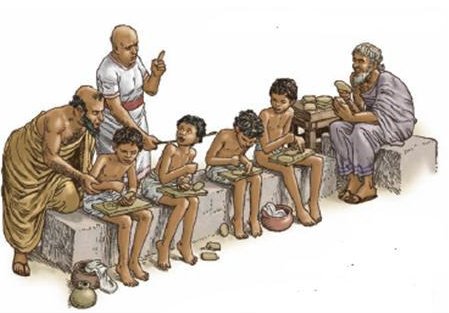
Difficult to Translate - Safa
This is actually quite a hard passage to translate, which is why you won't find agreement in the several versions. The Hebrew uses the word safa which is rendered in numerous ways - 'band', 'bank', 'binding', 'border', 'brim', 'brink', 'edge', 'language', 'lip', 'prating', '([sea-]) shore', 'side', 'speech', 'talk', '[vain] words'.
Even Harder to Translate - Davar
The second of the two words, davar, is well know to everyone as meaning 'word', and more often, 'spoken word', but it can be rendered in dozens of ways depending on context - 'act', 'advice', 'affair', 'answer', 'X any such (thing)', 'because of', 'book', 'business', 'care', 'case', 'cause', 'certain rate', 'chronicles', 'commandment', 'X commune (-ication)', '+ concern [-ing]', '+ confer', 'counsel', '+ dearth', 'decree', 'deed', 'X disease', 'due', 'duty', 'effect', '+ eloquent', 'errand', '[evil favouredness-]', '+ glory', '+ harm', 'hurt', '+ iniquity', '+ judgment', 'language', '+ lying', 'manner', 'matter', 'message', '[no] thing', 'oracle', 'X ought', 'X parts', '+ pertaining', '+ please', 'portion', '+ power', 'promise', 'provision', 'purpose', 'question', 'rate', 'reason', 'report', 'request', 'X (as has) said', 'sake', 'saying', 'sentence', '+ sign', '+ so', 'some [uncleanness]', 'somewhat to say', '+ song', 'speech', 'X spoken', 'talk', 'task', '+ that', 'X there done', 'thing (concerning)', 'thought', '+ thus', 'tidings', 'what [-soever]', '+ wherewith', 'which', 'work'.
Highlighs of Difficulties Translators Have
I share this to make a number of points, some of which bear repeating:
- 1. Classical Hebrew has a small vocabularly so one word had to serve many diverse meanings;
- 2. Only the context can reveal its actual meaning;
- 3. Sound translations require the services of experts and even then they don't always know the original meaning;
- 4. This means that even Interlinears differ in their literal English translations; and
- 5. The ancients frequently did not think at all in the same way that we 21st century Westerners do.
Kohlenberger's Masterpiece Interlinear
To illustrate another Interlinear which uses the same Masoretic text:
"Now-He-had all-of the-earth language one and-words common-ones" (Gen.11:1, John R. Kohlenberger III Interlinear)
The Spoken Universal Language Before Babel Had Many Dialects
This is very clear. Everyone spoke one language and even though there were various dialects they all used the same common words. In other words, language is never static, it's always changing but everyone back then could still understand one another well enough in spite of this natural tendency. Imagine, if you will, the whole world speaking English but with different groups using North American, British, Australian, New Zealand and South African dialects. We can all communicate with each other because we all use the same common words. It was the same back then before the confounding of tongues.
My Paraphrase of Genesis 11:1
Kohlenberger brings out this sense beautifully. Therefore I would paraphrase this passage as follows:
"The whole world had one written language and a set of commonly used words that everyone spoke and understood" (Gen.11:1, CCMW).
The Need for Both 'Literal' and 'Dyanamic Equivalent' Translations
So Esposito's translation is certainly not wrong (as a more-or-less 'literal' translation of the Greek LXX) but it does not really convey the original sense of the passage, which is what I personally am looking for. Once again, we see the tension between choosing a 'literal' over a paraphrase or dyanamic equivalent rendition. The safest bet is undoubtedly both, side by side, wherever that is possible. Hence the desirability of many translations!
7. "THE LIP ONE TO ALL OF THEM"
I had to cringe reading the next passage as the English must surely rank as amongst the worst in this translation, proving that you simply cannot render a literal word-for-word translation from an ancient language to a modern one without collapsing any semblance of grammatical sense:
 "And YAHWEH said, Behold, the people is one, and the lip one to all of them, and this they are beginning to do, and now all which they have determined to do will not be restrained from them" (Gen.11:6, HRB).
"And YAHWEH said, Behold, the people is one, and the lip one to all of them, and this they are beginning to do, and now all which they have determined to do will not be restrained from them" (Gen.11:6, HRB).

Twisted Greek Interlinear
There is no doubt Esposito lifted this from an LXX Interlinear before randomly recobbling it ... "...the lip one to all of them" is the literary equivalent of someone pressing half the keys of a piano down together to make one giant dischord. Couldn't he at least have followed Brenton's LXX translation?
"And the Lord said, Behold there is one race, and one lip of all, and they have begun to do this, and now nothing shall fail from them of all that they may have undertaken to do" (Gen.11:6, LXX, Brenton).
Simply the Same Language
The NASB's "they are one people, and they all have the same language" would have sufficed.
8. ADDING EVIL TO SPEECH
 "Come, let Us go down and mix up their language so that they cannot understand man's evil speech" (Gen.11:7, HRB).
"Come, let Us go down and mix up their language so that they cannot understand man's evil speech" (Gen.11:7, HRB).
Where did Esposito dig up the word "evil" from? There can be no doubt they were engaging in evil banter but this is not what the text says in either Hebrew or Greek of any MS that I have been able to locate:
"Come, and going down, let us confound their language, that they should not hearken to each the voice of the neighbour" (Gen.11:7, LXX, Interlinear).
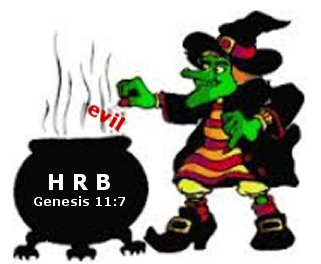
However you cut it, the final phrase can only mean one thing:
"Come, let us go down and confuse their language so they will not understand each other" (Gen.11:7, NIV).
From Translation to Commentary
Esposito cannot claim to be making a 'literal' translation and then start adding words that aren't there. By inserting "evil" he is switching from translation to commentary which he nowhere says he is doing. This is, after all, supposed to be a restoration of the 'original Bible'. Clearly it is not.
Enough of Esposito's Genesis
As more and more of this kind of error started cropping up, I got tired with Esposito's Genesis and was about to pack up this study altogether and dismiss the HRB as a poorly done work both as a literal translation and as readable English literature. But I'm going to give the HRB one last chance so let's take a look at John, and see how he handles the Aramaic and Greek texts there...
PART B - GOSPEL OF JOHN
Esposito's New Testament Sources
Before embarkling on a short study of the HRB's translation of John, let us see what Esposito says about the source texts he used:
"When putting together this Hebraic Roots Bible, I took the Peshitta text for the New Testament and its translation by several predominant scholars, such as George Lamsa, Murdock, Paul Yonan, and compared passages from both the Khabouris Codex, and from Gabriel Roth’s Ruach Qadim book. In checking with these various Aramaic translations of the Peshitta text, I also closely compared them to the Greek translation and prayerfully tried to give a literal translation of what the original intent was of each books writer from the original language and circumstances. I do believe that the Greek translation helped much in this regard."
The Influence of Gabriel Roth
I know Gabriel Roth's books quite well, and especially his very useful and scholarly Aramaic English New Testament (AENT, 2012) and his earlier, Ruach Qadim: Aramaic Origins of the New Testament (2005). I was less convinced by his book, Wheel of the Stars: The Ancient Biblical Calendar of the Future (2010). I do not agree with a number of Roth's theological conclusions which appear to be strongly influenced by Rabbinical Judaism, Kabbalism and by an ultra-messianic spirit. I mention this only because the influence of Roth's work is apparent in Esposito's New Testament portion or the HRB.
Discerning Original Intent
It is a good thing to try to discern each New Testament writer's "original intent". That is no easy matter, mind you, particularly when it comes to John (who can be very esoteric at times) and Paul (who had an incredible mind). I am grateful to both the textual scholars and to the preachers led by the Ruach (Spirit) in their several exegeses.
Johannine Mentors
My principle Johannine mentor was J.C.Fenton of St.Chad's College, Durham, England who gave me my initial grounding back in the 1980's. Though not often agreeing with them, other Johannine scholars who have sharpened my theological wits have been Sydney Temple (one time Professor of New Testament at Huron College of the University of Western Ontario, Canada), J.L.Houlden (one time Principal of Cuddleston Theological College, Oxfordshire, England, that contains the Anglican Church's foremost seminary) and John Marsh (one time Principal of Mansfield College, Oxford, England, who has written an excellent commentary on John). I have also dipped into the work a number of Johannine scholars working on the Qumran materials like James H.Charlesworth, Raymond E.Brown, James J.Price, A.R.C.Leaney, A.Jaubert, G.Quispel, M.E.Boismard and William H.Brownlee. The Qumran cache, which was 'the big thing' when I was at Oxford (at which time I got to know Geza Vermes, as I have already mentioned), led me to George Lamsa in 1984 and then, after I became messianic in 1999, to James Trimm's work and to a serious study of the Peshitta. Only in recent years have I been reading Roth's materials. So that's my background, broadly-speaking.
Charles Burney and the Aramaic John
Esposito, like Trimm, Roth and others, has good grounds for using the Peshitta, at least as far as John is concerned. Charles Burney (1868-1925) was a Senior Scholar of St.John's College, Oxford (a remarkable coincidence name-wise) and lecturer in Hebrew and became a Fellow of St John's in 1899 and Vice President in 1900. In June, 1914, Dr. Burney became the Oriel Professor of the Interpretation of Holy Scripture, and was also elected a Fellow of Oriel College, Oxford in 1919. Burney, and a number of others, claimed the Fourth Gospel was originally written in Aramaic and only translated into Greek as a completed book. He also argued for its early writing.
The Target Audience
For the Gospel of John to make sense, and particularly its unique literary style, you have to know a little bit about the author's intended audiences, for he had more than one in mind. In spite of its Aramaic language, John's target was the Greek pagan world - the Platonists, Stoics, Hermeticists, Gnostics, Mandaeans and the various mystery religions of the time. This explains what might be termed its 'Greek characteristics' which has fooled many scholars into believing it had to have originally been written in Greek and not a Semitic tongue. Thus any attempt to smooth over these 'Greek characteristics' would be to miss the point altogether. I think one of the reasons John is so readable to us today is precisely because of our own European/Western civilisation which is rooted in Greek and Latin. John makes it easier for us with such a cultural background to make the 'right connections'. And as such, his Gospel is a creative masterpiece, and a reason why so many scholars have been baffled by it.
What to Look for in a Translation of John
So when I read a translation of John I want to make sure all of this remains intact and that it has not been deliberately 'restyled' to make it readable to a Hebrew audience. Of course, it was for Israelites too, but more specifically for those who lived in, knew, and understood the surrounding (and let's be truthfull, penetrating) Greek culture. The Eastern Mediterranean was Greek, and had been for many centuries. If that offends Hebrew supremacists, too bad. Reality is the name of the game.
An Example of Platonism
Without writing a whole book on the subject, let me give an illustration or two. Platonic philosophy was pervasive in John's day and taught that behind this world of space and time - which was always changing and its components 'passing away' - there was a real, eternal, changeless world. This led to the contrast between mind and body, spirit and flesh, the world above and the world below, which all have echoes in John. The claim made by Yah'shua (Jesus) to be the true or real vine, or to be the One whose judgment is true or real (Jn.15:1; 8:16) are likewise echoes of this popular Platonic philosophy: the real vine that bears fruit for Yahweh is Yah'shua (Jesus) Himself, and vines in the vineyard are but pale copies of Him.
Using the Language of the Heathen
This is simply an example of John being a good evangelist, using the common vernacular and cultural thought pictures of the people he was witnessing to. Yah'shua (Jesus) may not have used this literal wording (which is why John reads differently to the Synoptists) but this was certainly the Messiah's meaning. These are the forms Yah'shua (Jesus) would have used had he been preaching to and teaching Greek Platonists and others. Therefore what John puts on the lips of Yah'shua (Jesus) are absolutely true and inspired. And if certain Platonic concepts are thereby validated as true, then so be it. We cannot, like many ultra-messianic fanatics, simply demonise all other philosophical teachings as a whole. Indeed, it would have been strange had Yahweh not left some emet (truth) with the pagans. Platonists reading John would have resonated and chosen salvation. And that is what preaching is all about. It's why Paul quoted a Greek philosopher in Athens to win converts (Ac.17:23).
1. EVERYTHING EXISTED THROUGH HIS HANDS
 "Everything existed through His hands, and without Him, not even one thing existed of the things, which have existed" (Jn.1:3, HRB).
"Everything existed through His hands, and without Him, not even one thing existed of the things, which have existed" (Jn.1:3, HRB).
I cite this simply to show how Esposito has made excellent use of Gabriel Roth's Aramaic English New Testament (AENT) which he has quoted word for word here. The expression, "everything existed through his hands" is almost unique to Roth [8] who explains in a footnote that this is the literal Aramaic reading, a metaphor to show that the Davar/Miltha/Logos (Word) is a creative force [9]. Though Esposito footnotes this verse, he does so only to discuss the Messiah's pre-existence and says nothing about his source or atypical rendering. A credit to Roth, or whoever the source was, would have been the right thing to do.
A Universally Accepted Translation
Whatever translation you use, the basic meaning remains, whether it be "all things came to be through Him, and without Him not even one came to be that came to be" (ISRVe1) or "all things were made through Him, and without Him nothing was made that was made" (NKJV).
NKJV
2. BELIEVING INTO SOMEONE
 "But as many as received Him, to them He gave authority to become sons of Elohim, to the ones believing into (beh) His name" (Jn.1:12, HRB).
"But as many as received Him, to them He gave authority to become sons of Elohim, to the ones believing into (beh) His name" (Jn.1:12, HRB).
 "For YAHWEH so loved the world that He gave His only begotten Son, that everyone believing into (beh) Him should not perish, but have everlasting life" (Jn.3:16, HRB)
"For YAHWEH so loved the world that He gave His only begotten Son, that everyone believing into (beh) Him should not perish, but have everlasting life" (Jn.3:16, HRB)
In, By, On or Into - You Choose
There is nothing technically wrong with either of these translations, nor the many others which speak of being "in Messiah (Christ)" since the Aramaic beh can be translated either "in Him", "by Him", "on Him" or "into Him", a point Roth correctly uses to prove that the Gospel of John (and indeed the whole of the New Testament) was originally written in Aramaic and not Greek, since the Greek translators never seem quite sure which to use [10]. I am quite sure Esposito has used Roth's scholarship here (he admits he has studied the book, Ruach Qadim) but he has not explained why he has chosen the rarer "into" over the almost universally used "in" rendition.
Another Case of Bad English
The fact of the matter is that in the English language we don't believe 'into' people, we believe 'in' them, so why has Esposito used 'into'? Just to be different? To be 'in Messiah' implies, obviously, that you have to first go 'into' Him - the initial spiritual rebirth or regeneration - but we no more keep on going 'into' Him than Yah'shua (Jesus) is recrucified again and again in every Catholic Mass.
Sensationalism
As Roth himself points out in his commentary on John 3:16 [10], all four meanings are simultaneously included in the beh proclitic, so the question for the translator is, which English word covers all senses? Roth is in no doubt as he continues with "in Him" in his AENT like almost every other scholar I have heard of. Esposito ends up mutilating the English language and leaves the reader in doubt as to what is exactly meant. Since by his own admission he is not a scholar, then he has to fall back on the claim that the 'Spirit' led him to choose 'into Him'. I think not. I believe he has used 'into' for the sensationalistic 'wow effect' produced 'into' those (sorry, was being a little humorous) whom he is trying to impress into accepting that his translation is unique, special and the 'original Bible' restored. I don't buy it.
3. TO TABERNACLE OR DWELL
  "And the Word became flesh and tabernacled among us And we beheld His glory, glory as of an only begotten one from the Father, full of grace and of truth" (Jn.1:14, HRB)
"And the Word became flesh and tabernacled among us And we beheld His glory, glory as of an only begotten one from the Father, full of grace and of truth" (Jn.1:14, HRB)
P'shat or Drash?
I have two gripes with this translation. First, with the word "tabernacle". All the truly scholarly messianic translations that I know of render the Aramaic word  [11] to simply mean "[and] dwelt" (HRV, AENT, RSTNE) or "lived" (CJB, APNTT). Yes, the word literally means 'tented' or 'encamped' as it does in Greek (skenoo) because in the earliest days, when the Semites were bedouin herdsmen like Abraham, people lived in tents. To make the word mean more than that is simply to indulge in a drash. What's important is the p'shat or literal meaning of the word. So when people later came to live in brick and stone houses, they still 'tented' (lived) in them. [11] to simply mean "[and] dwelt" (HRV, AENT, RSTNE) or "lived" (CJB, APNTT). Yes, the word literally means 'tented' or 'encamped' as it does in Greek (skenoo) because in the earliest days, when the Semites were bedouin herdsmen like Abraham, people lived in tents. To make the word mean more than that is simply to indulge in a drash. What's important is the p'shat or literal meaning of the word. So when people later came to live in brick and stone houses, they still 'tented' (lived) in them.

Doctrinal Motivation
It is only those pushing a preconceived doctrinal agenda (trying to prove Yah'shua/Jesus was born during the 'Feast of Tabernacles/Sukkot', for example) who - "made his sukkah, his Mishkan (Tabernacle) among us" (OJB), "tabernacled" (MRC - though including the footnote, 'or dwelt) and "pitched his Tent" (HS, ISRV - with the misleading footnote, 'an indication that His birth was during the Festival of Booths').
More Grammar
My last gripe was simply poor, clumsy English, repeating "of" twice in "full of grace and of truth" which should either be "full of grace and truth" or "full of grace and full of truth"
4. TENSE JUMBLE
 "John witnessed concerning Him, and has cried out, saying, This One was He of whom I said, He coming after me has been before me, for He was preceding me" (Jn.1:15, HRB).
"John witnessed concerning Him, and has cried out, saying, This One was He of whom I said, He coming after me has been before me, for He was preceding me" (Jn.1:15, HRB).
Any hopes I might have had that Esposito's English would improve in his New Testament exercise (and especially the Gospel of John) because he seemed to be using the works of some sound scholars, quickly became dashed. I am only 15 verses into the first chapter and it's really quite appalling. Why didn't he just follow his mentor Roth?
"Yochanan witnessed concerning him and cried out and said, 'This is whom I said would come after me, and yet be before me because he was earlier than me" (Jn.1:15. AENT).
Esposito seems to have little concept of how to uses tenses and doesn't understand that Hebraic tenses are a little different from our own.
5. LAW BUT NOW GRACE AND TRUTH?
 "For the Torah was given through Moses, but grace and truth came through Yahshua Messiah" (Jn.1:17, HRB).
"For the Torah was given through Moses, but grace and truth came through Yahshua Messiah" (Jn.1:17, HRB).
The Reasons They Add 'But'
I have picked this passage out simply because it is controversial. Why? Because the word "but" does not appear in the Greek translation even though nearly all the older Protestant translations put it in, though when they're honest, they put it in italics, as the NKJV and KJV do. Why do the older Protestant versions insert this word? It isn't just to be grammatical or to improve the style but because this passage is one of the show-case scriptures of the antinomians - those against living the Torah in the New Covenant. The word "but" is used with the intent to 'showing' that we have moved from Torah-obedience to living exclusively by grace, Yahweh's unmerited favour.

The Messianics Who Follow the Greek
So we should not be surprised to find messianic translations like those by Koster that use the Greek text making a point of leaving the mischievous word 'but' out (since it was never originally there):
"For the Torah was given through Mosheh - the favour and the truth came through YHSH Messiah" (Jn.1:17, ISRV & HS)
although saldly many messianic versions like these prefer "favour" to the better-known and more theologically-correct "grace". Stern does the same:
"For the truth was given through Moshe; grace and truth came through Yeshua the Messiah" (Jn.1:17, CJB).
Modern Protestant Versions are More Accurate
Modern Protestant English Bibles are being honest enough now to correct this translation error, I'm glad to see:
"[For] the law indeed was given through Moses; grace and truth came through Jesus Christ" (Jn.1:17, NRSV & ESV).
Catholic versions, like the JB and NAB, put their own spin on this passage which we'll not go into today.
Esposito's Correct Understanding
We'll come to why Esposito probably inserted "but" into his text in a moment but even with that word inserted, he makes plain what the verse means in a footnote:
"The purpose of the Torah was never to give salvation but to teach us how to live (Ps 119:105). Only the shed blood of Yahshua can justify someone and pay the penalty of
their sins."
Roth's Commentary
Full marks for Esposito there. Roth also adds a useful commentary to the AENT version of this passage:
"The Torah of Moshe is the Word of YHWH, but grace and truth revealed in Y'shua are the impelling forces that uphold all righteousness and keep the Word of YHWH (Torah) positioned in our hearts; these are complimentary, not opposites. It is according to the Grace of the Father YHWH that Mashiyach is revealed in a person's heart; see John 17:9,10".
The Aramaic Includes the 'But'!
It is a matter of interest that the Aramaic  ('but') is in the Hebraic form which may distress those who have fought antinomians over the inclusion of the word in the Greek. Why did the Greek translator(s) leave the word out? We may never know unless it was simly to remove any ambiguity. What we can be sure of is the meaning ascribed to antinomians ('[something bad] but [now something good]') is false anyway, with or without a 'but'. To ascribe badness of any kind to Yahweh is quite simply blasphemy, which is what antinomianism is anyway. ('but') is in the Hebraic form which may distress those who have fought antinomians over the inclusion of the word in the Greek. Why did the Greek translator(s) leave the word out? We may never know unless it was simly to remove any ambiguity. What we can be sure of is the meaning ascribed to antinomians ('[something bad] but [now something good]') is false anyway, with or without a 'but'. To ascribe badness of any kind to Yahweh is quite simply blasphemy, which is what antinomianism is anyway.
6. PRE-EXISTENCE OF MESSIAH
  "This One it is who has come after me, who has existed before me, of whom I am not worthy that I should loosen the strap of His sandal" (Jn.1:27, HRB).
"This One it is who has come after me, who has existed before me, of whom I am not worthy that I should loosen the strap of His sandal" (Jn.1:27, HRB).
Correct But Commenting, Not Translating
Esposito is trying to (correctly) bring out the preexistence of Messiah in this passage but, in my view, going beyond the literal Aramaic by adding commentary ('has existed') which is what he says he aspires to render literally:
 "this is he who after me will come yet who before me is"
"this is he who after me will come yet who before me is"
Poor Tense Usage
As you can see, Esposito is still very weak on his use of tenses. Trimm, in my view, gives the best translation here:
"This is the one who will come after me yet was before me..." (Jn.1:27a, HRV).
A Revelation About Preexistence at All?
This is admittedly not an easy passage to translate into English as we don't exactly have a verb of being that confirms both past and present (and indeed future too). Others, like Koniuchowsky (who follows the KJV), don't even think this is a revelation about pre-existence and say, "He whose coming after me is preferred before me" (RSTNE) which gets one sense of the cluster of meanings over but at the expense of all the rest. And Koster's, "the One coming after me, who has become before me" (ISRV & HS) is a hopeless jumble. Worse still, Stern leaves it out together!
"He is the one coming after me" (Jn.1:27, CJB).
The Goble Gloss
And like Stern, Goble just glosses over the revelation of preexistence altogether:
"Hu HaBah (he who comes, i.e. the Rebbe, Melech HaMoshiach who is coming into the Olam Hazeh), that is, He who comes after me..." (Jn.1:27, OJB).
A Huge Difference
Oh dear oh dear. What a huge difference 'that is' or 'yet' makes to the overall meaning -'that is' merely restates the first proposition twice whereas 'yet' created a contrast between two different propositions. So let's stick with the Peshitta, even if this translations isn't necessarily the best either:
"This is he who will follow (come after) me, yet was before me..." (Jn.1:27, APNTT).
A Review
I'm afraid time prevents me continuing with this project, which was rather bigger than I had planned, but hopefully I can continue another day. I have more pressing matters to attend to for now. You, the reader, will at any rate, I hope, have got a 'feel' for the HRB now and also learned a few things from the Septuagint and Peshitta on which it claims to be primarily based.
The Main HRB Weaknesses
Aside from some of the doctrinal errors in the footnotes, I think the main weakness of this version is its poor English. I don't mind 'literal' versions if they are accurate but when I feel the need to keep double checking almost every other verse, then the pleasure is lost in reading it. There is no doubt this version, though not a scholarly translation, has some good points. Most importantly, the author grossly over-exaggerated its importance as this is certainly not a restoration of the 'original Bible'. That alone should invite suspicion which, upon closer examination, has proven to be well founded.
The English of the HRB
It is hard to know exactly what 'style' of English Esposito uses and at first I thought it had something King James Version-ish about it. Upon closer inspection, it turned out to be a mishmash of all kinds of English. There is no obvious attempt at polishing. Unlike the King James translators, though, who were literary geniuses and in the process defined Standard English for generations, or the more recent New King James Version which modernises the English while keeping the old Jacobean style, there is little I personally find in the HRB that merits it as a literary work. The English is frankly awful in places, failing to accomplish what the NKJV translators did in bringing 17th and 20th century English together in a palitable form in a literal format.
Compared With Other Messianic Versions
But Esposito is by no means alone. In spite of his undisputed scholarly ability, which is his chief attraction, the English of Trimm's Hebraic Roots Version (HRV) leaves much to be desired too, though it is not nearly as bad as Esposito's. Indeed, the only messianic version with any decent style is Stern's paraphrased Complete Jewish Bible (CJB) and its predecessor, the Jewish New Testament (JNT).
The Importance of Good Grammar and Syntax
Like it or not, people will be preferentially drawn to a well-written text than to one claiming scholarly or doctrinal excellence which stumbles all over the place as it tries (unsuccessfully) to find its literary feet. Grammar and syntax are important in making a language 'work', especially one claiming the Hand of Elohim (God).
What I Shall Use the HRB For
I shall be keeping the HRB for reference alongside the many other versions I possess but it isn't one I shall be reading for either personal edification or for use in our local congregation. Though I had hoped - against all hope - for something that could be a worthy replacement of the NKJV coupled to the HRV or AENT for use at home and in the assembly, I have to say it falls far, far short of that wish. The footnotes, too, are a mixed bag, some really useful and others very misleading. There is too much of the Armstrongite dogma still in Esposito.
Conclusion
I cannot therefore, in all good conscience, recommend this Bible version except strictly alongside the many other messianic versions currently around for purely comparitive purposes. I am sure the author was hugely blessed making the translation, as anyone attempting such an ambitious project must surely be, and perhaps he will improve it over time but without the pompous and undeserved title, 'the original Bible'.
Endnotes
[1] For other trickly translation passages of Scripture, see Five Hard Bible Passages and What They Mean: Understanding the Difficult Parts of the Bible
[2] The best example of Monism would be the religion of Hinduism which assumes that 'God' is all-inclusive. The Bible, by contrast, rests on the concept of Dualism which posists two ultimately irreconcilable substances or realities such as Good and Evil. No such distinction exists in monism, a reason why it is attractive to those who espouse sinful practices condemned by the Bible.
[3] Some words previously translated as masculine in early version of the Bible like the KJV do originally refer to both genders. In these cases, it is legitimate to add the female reference. That is why the Colorado Springs Guidelines for translation of gender-related language in Scripture was drafted by 10 prominent evangelical Christian leaders in 1997 to deal with such cases (see the reprint of the Guidelines in the report by Poythress and Grudem). It was later endorsed by over 50 evangelical theologians. The guidelines clearly define what kinds of words can be translated to reflect both genders. For example, one of the rules is: “Brother” (Greek adelphos) should not be changed to “brother or sister”; however, the plural (Greek adelphoi) can be translated “brothers and sisters” where the context makes clear that the author is referring to both men and women - see Gender-Neutral Bibles
[4] See Part 3 of this series, Section #6
[5] See the very handy online Interlear Greek-English Septuagint Old Testament. We strongly recommend students of the Bible get their own hardcopy LXX
[6] See the handy online Dead Sea Scrolls Bible Translations
[7] The Compact Edition of the Oxford English Dictionary (OUP: 1971), pp.2925-2928
[8] Janet M.Magiera uses "Everything existed by his hand" - Aramaic Peshitta New Testament Translation (APNTT): Aramaic Version (Light of the Word Ministry, LWM Publications, USA: 2009), p.212. This cosmetic 'translation' (like Esposito's) has no footnotes.
[9] Gabriel Roth. Aramaic English new Testament (Netsari Press LLC, USA: 2012), p.232, footnote #4
[10] Gabriel Roth, Ruach Qadim: Aramaic Origins of the New Testament (Tushiyah Press, USA: 2005), p.161
[11] See, for example, the online Peshitta Interlinear New Testament
[12] Gabriel Roth, AENT op.cit., p.233, footnote #13
Read the Hebraic Roots Bible free (PDF file)
(This text may be downloaded but must not be altered or sold)
To buy a hardcopy, go the the
Congregation of Yahweh, Jerusalem website

|


